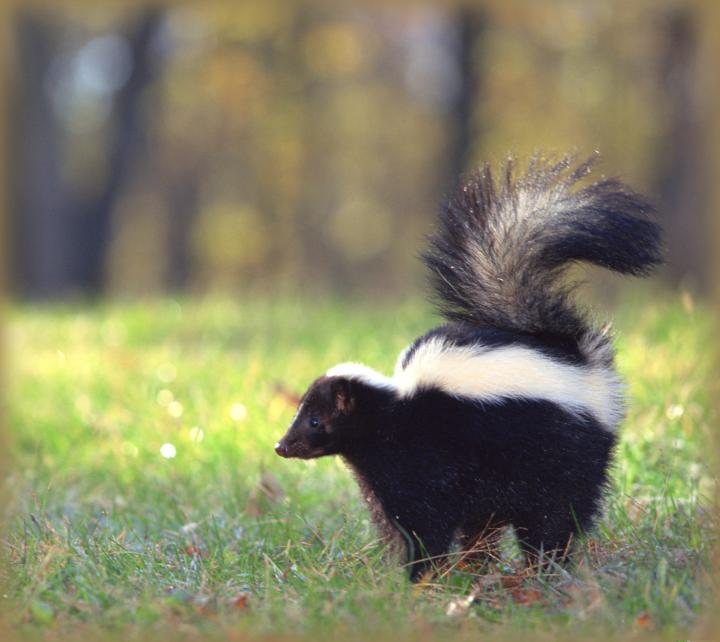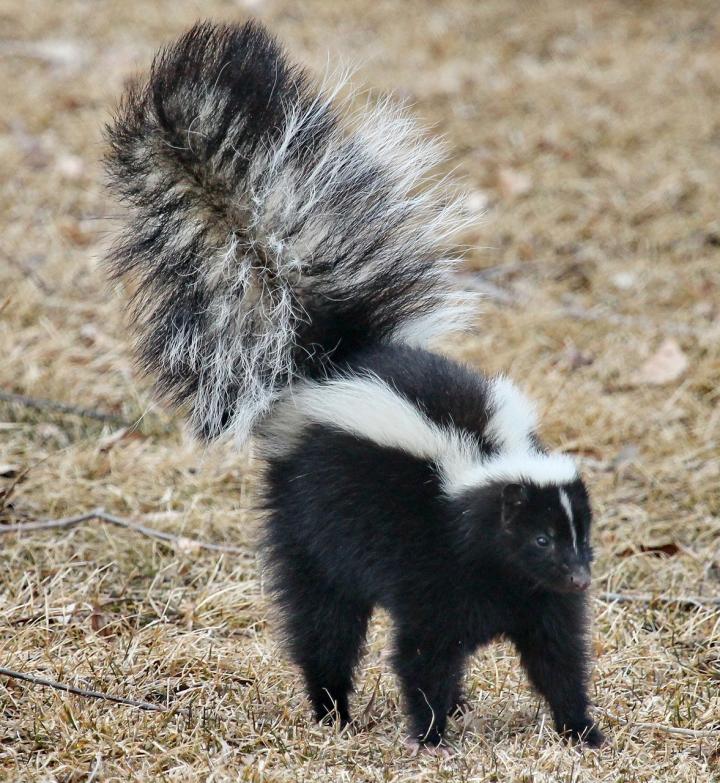






Skunks are docile animals but may spray if threatened.
Here are tips on how to identify and get rid of a skunk in your garden.
Skunks are nocturnal animals that are naturally mild-mannered and non-aggressive; they prefer small animals and insects for dinner instead of your garden. They occasionally visit gardens and if they do, it may be because corn or other plants are close to the ground.
The skunk claims homesteading rights from coast to coast. Distributed across the country are 4 species of skunk, including the striped skunk (Mephitis mephitis) and the spotted skunk (Spilogale putorius). The common striped skunk, allergic to strenuous life in deep forests, lives mostly in fry, rolling, well-watered country.
Skunks can be very nice to have around because they dig up and feed on the larvae of cutworms, Japanese beetles, hornworms, and other crop-destroying insect life. However, skunks are not partial to insects. They will eat leaves, buds, grasses, grains, garbage, any fruit or berries within reach, and even small game. This is what can make them a bit of a nuisance to gardeners.
Although their nocturnal wanderings around our fields and gardens, lawns, and flower beds cause us occasional inconvenience and uneasiness, these are minor faults which can be readily overlooked by the time the Harvest Moon begins to shine. It is then that the skunk’s appetite for the pests that plague our gardens helps make it possible for that Moon to glow over a horn brimming with plenty.

Skunks are famous for their skunk spray—you can smell an angry skunk from over a mile away. Furthermore, a skunk can “shoot” you from 10 to 12 feet, sideways, up, or down, with little apparent effort. Most gardeners worry more about a skunk spraying in the garden, on the gardener, or on a pet than about a skunk chewing up some veggies.
Under a skunk’s tail are two pouches equipped with a pair of ducts which, in peacetime, remain hidden, but which quickly expose themselves when danger threatens. Their foul ammunition is a golden-yellow liquid whose active ingredient is the sulfide mercaptan. Each of the two pouches contains enough ammunition for six rounds. After the supply is exhausted, a week’s time is required to replenish it. This spray has made skunks creatures feared by nearly all animals, including most of mankind.
A skunk’s warfare is purely defensive. When confronted by a menacing man or clamorous dog, skunks will try to sidestep by ambling off. This means that if you find a skunk, simply turn back and you should be fine. If pursued, skunks will turn, face their aggressor, and stamp their forefeet. This is their first warning. At this point, you should really be running!
The second warning comes when their tails, all but the tips, are hoisted. Then, this ultimatum failing to establish the peace, the white tip rises, and spreads out, and the skunk, snapping into a U-position with snout and rear toward the target, delivers a charge of spray. At this point, it is simply too late, and your dog probably smells foul.
People usually get sprayed when they are walking through their yards in the dark (if you can’t see a skunk, you can’t run away), or if they disturb a skunk while eating. Those are good reasons to keep skunks out of your yard in the first place and to always carry a flashlight!
The striped skunk has prominent white stripes running down its back and black fur on the rest of its body. It is the size of a house cat and is the most abundant species of skunk in the United States. Spotted skunks are smaller and have white spots as well as broken white strikes amid their black fur. Skunks have short legs and proportionately large feet with well-developed claws that are good for digging.
Tracks can be helpful in identifying skunks. Skunks are often mistaken for raccoons, because they both have five toes. Sometimes the fifth toe is hard to see in skunk tracks. Their heels usually are not part of the tracks, and their claw marks are usually somewhat visible. Skunk droppings also often contain undigested insect parts.
Often, the best way to identify skunks is unfortunately by their odor. Hopefully you don’t have to deal with the skunk spray in your garden, but you’ll know for sure that you have a skunk as soon as they decide to spray.

If your lawn or flower bed has lots of holes in it, you may have a skunk problem. Skunks dig up the turf looking for grubs. They move around at night and dig in grassy areas, making distinct 3– to 4–inch deep holes. Skunk activity increases in the spring and then lessens naturally, so any problems may stop all on their own.
Skunks sometimes feed on corn, but they only eat the lower ears. If a corn stalk has been toppled over, the culprit is more likely a raccoon. Planting taller varieties of corn can minimize this damage.
Of course, skunk spray is a common sign of damage. If your dog smells foul, you probably have a skunk.
Oh no! We can all smell a skunk from miles away, but it’s truly awful to have that smell on you. If you or your pet gets sprayed by a skunk, try a mixture of 1 quart 3 percent hydrogen peroxide, ¼ cup of baking soda, and 1 to 2 teaspoons of liquid dish soap. Shampoo only the area sprayed by the skunk. Wet the area and work the solution into the skin or fur with your hands (avoid the eyes). Rinse. (This remedy may dry out the skin. If so, use a good-quality crème rinse to replenish moisture once the skunk smell is gone.)
Do you have any special remedies that you use for skunk spray? Let us know below!
How to Identify and Get Rid of Aphids
Flea Beetles: How to Identify and Get Rid of Flea Beetles
Mexican Bean Beetles: How to Identify and Get Rid of Garden Pests
Squash Vine Borer: How to Identify and Get Rid of Garden Pests
How to Identify and Get Rid of Rabbits
How to Identify and Get Rid of Raccoons
Squirrels: How to Identify, Control, and Get Rid of Squirrels in Your Garden
Copyright © www.100flowers.win Botanic Garden All Rights Reserved